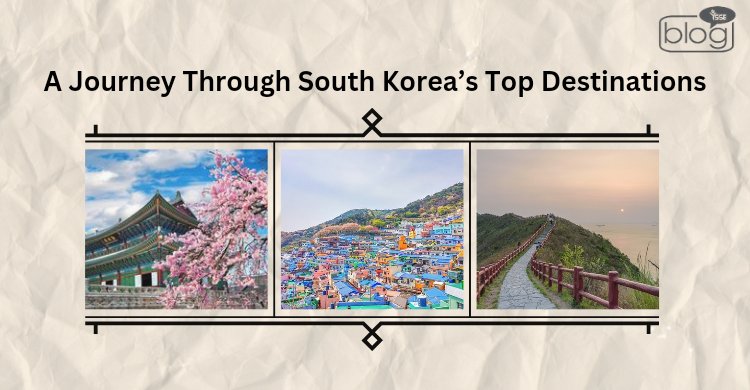South Korea is now a popular destination for people, especially for youths. The main reason South Korea gets noticed by so many people is because of their culture, their natural places, historic places, and the wide recognition for K-drama and K-pop. People, after learning about their favorite K-pop artist or drama, state their urge to visit South Korea as their vacation destination. I know you are reading this blog because you also want to know about South Korea’s beautiful places for quality time with your friends or family. Here, I will be talking about some beautiful destinations you can visit on your vacation. Who knows, you may get a chance to meet your favorite celebrity!
South Korea has many tourist spots to visit. They have many UNESCO-recognized historic heritage sites. Here, I will discuss the top 3 places and what spots you can visit.
Seoul: The Capital of South Korea
South Korea’s capital, Seoul, is a bright harmonization of archaic traditions and modern advancement. Home to over half the nation’s citizens, it is a cultural and commercial heart known for its fusion of old and new—modern superstructures alongside UNESCO-listed historical sites. The city’s rich history, dating back to 18 BC as Wiryeseong, reflects regime changes, dynastic rule, and liberation, shaping its unique identity. Visitors can enjoy four grand palaces, countless temples, shrines, museums, and world-famous cuisine, from bustling street food stalls to fine dining.
Gyeongbokgung Palace, built in 1395, is the largest and most beautiful Joseon-era palace, featuring iconic structures like the Gyeonghoeru Pavilion and the National Palace Museum.
N Seoul Tower, atop Namsan Mountain, provides breathtaking views and cultural interactions, mirroring Seoul’s vibrant spirit. Bukchon Hanok Village protects traditional Korean architecture with a modern touch, showcasing Hanok homes tailored for urban living.
Lotte World Tower, a sleek landmark inspired by Korean art, combines retail, hospitality, and observation decks, offering stunning city views. Together, these attractions encapsulate Seoul’s dynamic mix of heritage, culture, and innovation.
Busan: The second largest in South Korea
Busan, a vital seaport in Asia, blends cultural richness, ethnic diversity, and a peaceful atmosphere, making it a perfect vacation spot. The city offers unique cuisine, serene temples, seaside activities, and a warm population, creating an inviting experience.
Haeundae Beach, Busan’s most famous white-sand beach, spans 1.5 km and draws locals and tourists alike with its lively, joyful vibes, especially on weekends and holidays. Beomeosa Temple, nestled in Geumjeongsan Mountain, is the third-largest temple in Yeongnam, offering a peaceful escape amid historical treasures like Daeungjeon Hall and stone pagodas reflecting Unified Silla’s beauty.
Gamcheon Culture Village, the “Machu Picchu of Korea,” transformed from a war refugee settlement to a vibrant artistic hub through the 2009 Village Art Project. Its pastel-colored maze-like houses, murals, workshops, and hanbok rental program offer a blend of history, art, and romance. Together, these attractions highlight Busan’s unique charm.
Beomeosa Temple in Geumjeong-gu, Busan, is the third-largest temple in Yeongnam, built during Silla’s reign and known for nurturing Buddhist monks. Nestled on Geumjeongsan Mountain, it features symbolic flagpole supports, stepping stones, and the Jogyemun Gate, emphasizing humility. Its mid-Joseon architecture harmonizes stone and wooden pillars, while Daeungjeon Hall, a National Treasure, showcases intricate carvings, Buddha Triad Wooden Statues, and paintings. Stone artifacts, like lanterns and the Three-story Stone Pagoda, reflect Unified Silla’s beauty. Surrounded by a serene valley and mountains, Beomeosa Temple offers peace, history, and natural beauty year-round.
Jeju: The Island of Volcano
Jeju is a Northeast Asian natural wonder and South Korea’s largest island. Known as the “Island of the Gods,” it is a favored honeymoon destination with serene, crater-marked landscapes, a mild subtropical climate, and UNESCO recognitions as a World Natural Heritage Site, Global Geopark, and Biosphere Reserve. Jeju boasts Korea’s highest peak, Hallasan Mountain, semi-tropical national parks, wild coastlines, and the world’s longest underground lava tube.
Its unique cuisine includes seafood caught by haenyeo, and female divers aged 60 and above, while volcanic soils nurture vibrant mandarin groves and exotic fruits. Jeju City is the island’s main heart, but its rural territories offer pure natural beauty, volcanic craters, waterfalls, and classic cottages made of black lava rock.
Hallasan National Park highlights South Korea’s sky-high mountain, Hallasan, with varied flora and fauna, vibrant autumn leaves, and frosted peaks in winter. This volcanic mountain, surrounded by 360 cones, has been a UNESCO Biosphere Reserve since 2002 and a World Natural Heritage Site since 2007.
Seongsan Ilchulbong Peak, a 5,000-year-old underwater-formed crater, offers panoramic views of Jeju’s volcanic scenery and attracts millions of visitors for its morning scenes. Bonded to Jeju through soil build-up, its summit features a 600 m-wide, 90 m-deep crater covered in silver grass, improving its natural charm.
To read more blogs, Click here
Writer
Anika Sharmila
Intern, Content Writing Department
YSSE.

